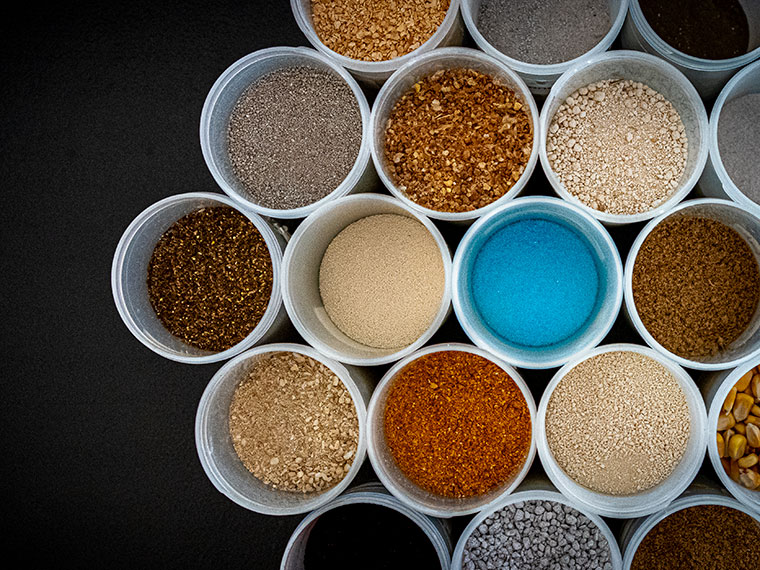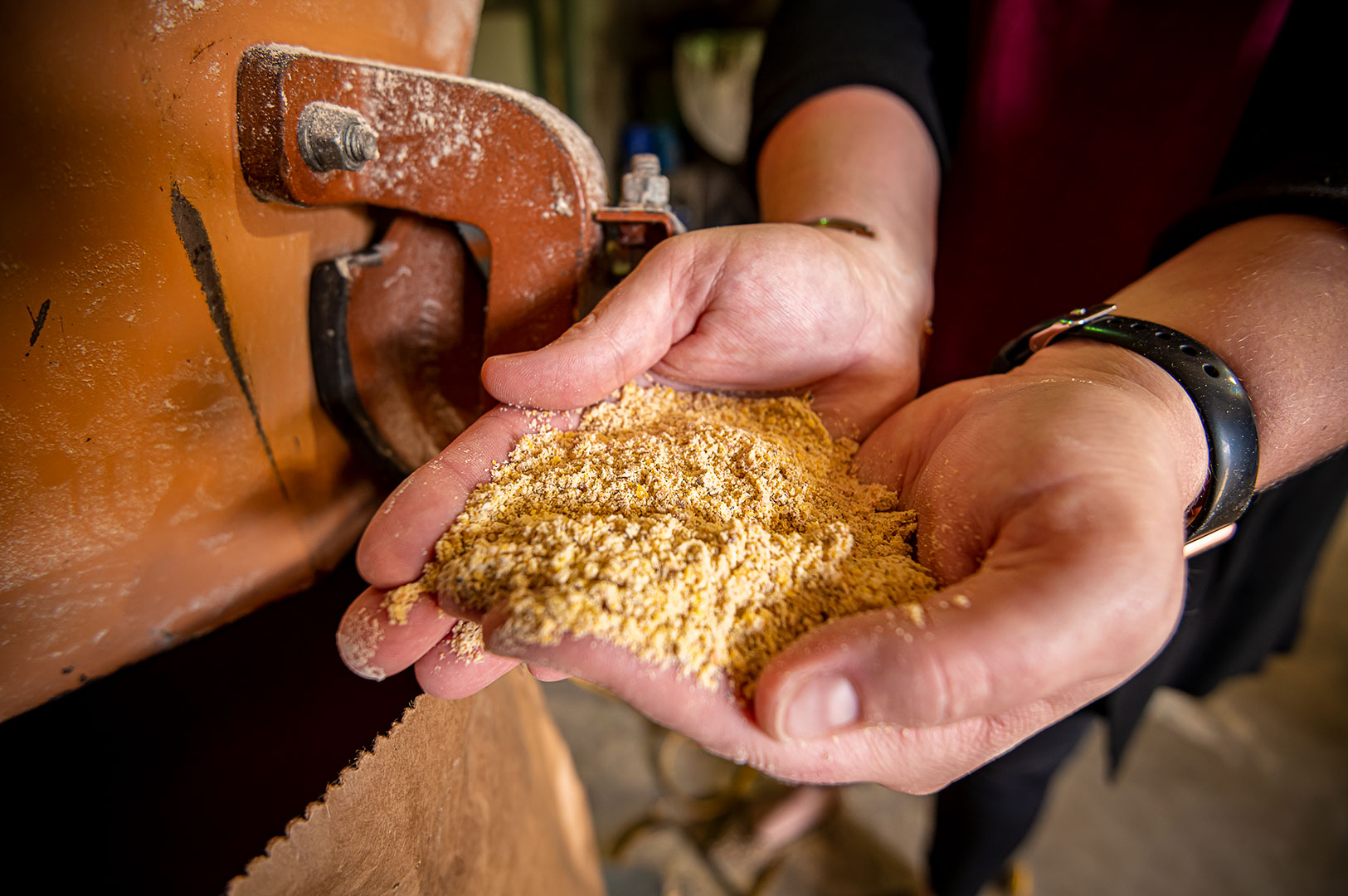The information presented on this page may be dated. It may refer to situations which have changed or people who are no longer affiliated with the university. It is archived as part of Mississippi State University's history.
The adage, you are what you eat, doesn't just hold true to people. It is also applicable to poultry, one of the most versatile and widely consumed sources of protein in the world. The nutrition consumed by chickens have a profound influence on the product that ends up on our plates.
Dr. Kelley Wamsley, a MAFES scientist in the Department of Poultry Science, has spent more than a decade working to improve the nutritional performance of commercial poultry feed.
In 2019, Wamsley began working with doctoral student Courtney Ennis to conduct a year-long investigation into phytase enzymes used in commercial poultry feed.
Phytase is one of the most used exogenous enzymes in commercial poultry feed. This enzyme has been of interest to the commercial animal feed industry since the 1960s and has been heavily researched. Phytase works on phytate-bound phosphorus. Poultry do not possess the enzyme to break down complex molecules like phosphorus that are present in common feed ingredients such as corn and soybeans. Phosphorus would typically pass through the bird undigested and end up in the litter. Enzymes are added to the feed, so the bird can digest some of the phosphorus that would otherwise be unavailable as well as other nutrients that may be bound to the phytate molecule, thus improving the overall performance of the feed on the bird. This also allows for reducing dietary costs, by lowering the use of inorganic phosphorus added to the diet, as well as reducing pollution from excessive phosphorus in the litter.
Wamsley, Ennis, and Dr. Curran Gehring, a nutritionist with Tucker Milling LLC, ollaborated with phytase companies to find out whether different phytase enzymes could work in combination and in other parts of the GI tract to capture as much phosphorus as possible. Ennis had found that previous research studies hinted at the possibility of coordination between phytase enzymes, an idea worth exploring.
"Dr. Wamsley challenged her graduate students to submit pre-proposals to the U.S. Poultry and Egg Association to secure research funding," Ennis said. "My focus was trying to come up with an idea that fit into my research interests, while finding practical answers for the poultry industry."
According to Wamsley, poultry nutrition is highly specific and tailored to the birds at various life stages, based on the nutrients it needs.
"Birds are monogastric animals, like we are, and they don't digest 100 percent of the nutrition they take in," Wamsley said. "Enzymes are added to the feed to increase the digestibility in order to make more nutrients available."
Over time, the development of these enzymes has changed, and today, several varieties of phytase exist with varying pH levels. And whereas the older phytases work more slowly but last longer, newer phytases are faster acting, but they do not last as long. Wamsley explained that most feed companies add only one type of phytase, but in this study, they proposed that perhaps combining multiple types of phytase might further improve digestibility, and thus, performance, of the feed for broilers.
"A great deal of research has already been conducted in the poultry industry on the usefulness of phytases," Ennis added. "However, we discovered a gap in the current knowledge base-the combined use of varying phytase enzymes."
Poultry nutrition is highly controlled, and feed manufacturers are constantly seeking to improve nutritional outcomes for several reasons, cost being a major concern.
"Nutrition is 70 percent of the cost to rear a bird," Wamsley said. "Broilers have very short production cycles depending on the market, ranging from about 35-60 days. You can make changes and see those changes happen very quickly."
Optimizing the nutritional impact of the feed not only benefits the bird, but there are environmental benefits as well. The feed not digested by the bird gets excreted and turned into waste, or "litter." If there are large amounts of excess nutrients, such as phosphorus, in the litter, it can runoff into rivers and streams and have negative environmental impacts. The more nutrients digested by the bird, the less run off escapes into the environment.
Wamsley and her team conducted two experiments from 2019-2020. In the first experiment, broilers were reared from 0-14 days to investigate the potential synergy of three different enzymes with different biochemical properties when fed alone or in combination with low-enzyme activities. In the second experiment, limitations from the previous experiment were addressed, including using a broader and more practical range of phytase activity, implementing three diets varying in calcium and available phosphorus, and employing an entire grow-out of broilers within experimental floor-pen facilities.
The data showed that a diet lowest in calcium and available phosphorus with a higher level of a single phytase resulted in improved broiler performance and nutrient digestibility. There was also some evidence of synergy in diets with medium levels of calcium and available phosphorus along with a lower level of combined phytases; however, performance was not maximized with these combinations.
Although the results from this study did not yield indisputable evidence that combining phytase enzymes improves nutrition performance in broilers, it did uncover the need to further research how the ratios of calcium and available phosphorus in feed can impact the efficacy of phytases. Wamsley also holds that further research on combined phytase enzymes, as well as other enzymes is warranted and could have significant environmental and economic benefits for the poultry industry.
Wamsley has plans to take these studies further, looking at other enzymes to determine whether there is a synergistic effect on the nutrients in poultry feed. Although poultry in the U.S. are commonly fed corn and soybean meal-based diets, ingredient quality can change and other alternative ingredients available are always changing according to what scientists believe will be best for the bird.
"If you don't have good nutrition, you won't have good health of the bird, and you won't have a good product," she said.
Wamsley admits that the efforts in this field will never be completely done.
"We've already done some of that work," she added, "but enzymes are constantly evolving, and we're always trying to use as many nutrients that are already in the feed to produce the best and healthiest products. We want to optimize every aspect of the process, so there's always research to be done in this area."
This study was funded by the Mississippi Agricultural and Forestry Experiment Station, the U.S. Poultry & Egg Association, the Harold E. Ford Foundation, and an endowing foundation gift from Peco Foods.
If you don't have good nutrition, you won't have good health of the bird, and you won't have a good product.
Dr. Kelley Wamsley
Behind the Science

Kelley Wamsley
Associate Professor
Education: B.S., Animal and Nutritional Sciences, M.S., Animal and Food Science, Ph.D., Animal and Nutritional Sciences, West Virginia University
Years At MSU: 9
Focus: Determining optimal feed form for modern broilers, amino acid requirements for current and emerging broiler crosses, practical application of feed additives, and diet formulation strategies to maximize broiler performance
Passion At Work: Our work can be utilized by poultry producers almost immediately, directly impacting the way poultry is produced and, ultimately, helping to feed the world's growing population.


